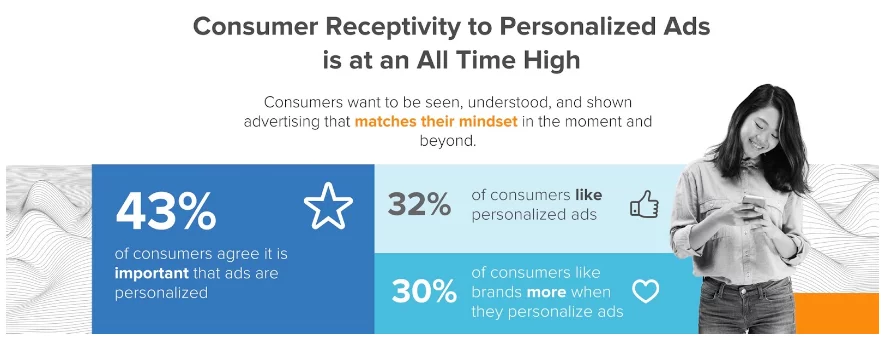Consumers have spoken and their message is clear: They want ad personalization.
According to Epsilon, 90% of consumers said they find personalization appealing, and 80% are more likely to purchase from a company if it offers personalized experiences.
Innovid also found that consumers prefer certain types of ad personalization when they are browsing their favorite sites:
- 39% want ads that fit into the context of their experience, like the web pages they visit
- 31% want ads that take their advanced demographic information, especially location, into account
- 29% want ads that address their online behaviors and preferences

Still, some advertisers have been slow to sign when it comes to incorporating ad personalization into their strategies and web pages. As Infogroup reported, 93% of consumers said they’ve received marketing communications that weren’t relevant to them, and they often find them annoying.
This isn’t just an advertiser issue, either. Publishers lose out on revenue and engagement if they share generic, irrelevant and impersonal ads from brands. And, without the right ad settings and strategies, they risk diminishing consumer trust and affinity.
That’s why we’re highlighting what publishers need to know about delivering personalized ads across channels.
Let’s take a look.
What is ad personalization?
Ad personalization is the process of customizing ad settings — like context, content, format, and targeting — to a specific user, demographic, or audience segment. Basically, publishers gather customer data to learn about people’s interests, historical behavioral patterns, and traits. They can then use that browsing data and advanced demographic information to create ads that are as relevant as possible.
Look, it’s 2022. We can all agree that ad personalization isn’t just slapping a name on an email and sending it to millions of people. It’s not merely about “Hey, [YourName], check out this deal!” That kind of “personalized content” just won’t cut it in this day and age. With all of the data and touchpoints we have to access, ad personalization has to be about multichannel messaging — reaching the right person on the right channel at the right time with the right content.

A sports brand, for example, could launch an ad to reach all web users. Or they could personalize it to specifically reach middle-aged football fans in North America who consume sports-related content on tablet devices over the weekend. This way, the brand can engage only the most relevant users and drive more value from their ad dollars.
Why is ad personalization so important?
There are a variety of reasons to prioritize ad personalization as a core part of your marketing strategy.
Let’s look at the biggest benefits of creating personalized content:
- Increased engagement. When you reach customers with personalized messaging that matches their interests, you increase the chance that they respond to and engage with your ads. As Jeeng found, over two-thirds of users say they’re willing to click on an ad if it’s relevant to their interests or if it appears on a site they trust.
- Improved trust. Trust is in low supply in the online marketing world. You can help build trust among your readers by delivering ads that cater to their needs instead of frustrate them and interrupt their content experiences. Especially if you have a subscriber list, you know you’re already working with a foundation of trust, since email is an opt-in channel. People choose to receive your messages in their inbox, and you don’t betray their trust by spamming them. You want to continue delivering value and prove that they can trust you with their email address.
- Advanced customer data. Each personalized ad campaign will deliver personalized customer data and analytics right back to the publisher. They can then mine that data for valuable insights, which they can then use to produce even more personalized and optimized ad experiences going forward.
- Greater ROI for publishers and advertisers. Increased engagement also yields increased ROI, especially if you base ad spend on cost-per-click or cost-per-conversion. According to Kibo, 70% of retailers using advanced ad personalization have seen an ROI of 200% or more. And 51% of retailers that used personalization in both their online marketing and shopping experiences saw an ROI of 300% or more. Adding personalization settings may even encourage advertisers to increase their ad spend, resulting in greater returns for publishers.
How can publishers deliver personalized ads?
Convinced about the power of ad personalization? Then it’s time to figure out how to make this strategy work for your publication.

Here are a couple of key ways to launch personalized ads that drive activity and results.
Use first-party data to learn about your audience
Third-party cookies are going away in 2022, when Google will officially disable them on Chrome browsers. Without the use of cookies, publishers will need to start finding a new way to collect customer data, like location, activity, browsing history, and interests, and track their online behavior across the web.
In fact, customers are also ready to stop dealing with third-party cookies and their terms and conditions. As we found in a recent study, 78% of consumers are uncomfortable with websites tracking their behavior online with tools like cookies, but they also expect their experiences to be personalized.
When you can’t use cookies, gathering and utilizing first-party data is the only way to show personalized ads, and stay helpful to users without compromising their safety online.
First-party data is collected directly from your readers through many powerful identifiers like the email address. It’s not tricky or secretive or confusing. It’s direct, transparent and reliable. With first-party data, publishers can better understand their customers, develop target audience profiles and help advertisers launch more accurate and relevant ads. Not only that, they gain control over the data and can better share targeted ads to select audiences.
Launch native ads for a more engaging customer experience
Ad personalization isn’t just about choosing an image or headline that appeals to a specific audience segment. It can also be about making sure your ads fit naturally into the surrounding page. This way, they don’t scream “LOOK AT ME! I’M AN AD!” and create a more intuitive, seamless experience for the user.
An email newsletter of trending articles, for example, can include a native ad from an advertiser that looks like just another article. Or a push notification from a publisher on a browser may be sponsored by a relevant brand promoting real-time deals, product releases or apps.
Get personal
There’s no way around it: Advertising is personal. It’s personal to your readers, your ad partners, and your publication. Yes, it’s about driving revenue, but it’s also about helping people meet their needs and interests with the products and services that are useful and matter most to them.
So embrace the personalized side of advertising and make sure you can reach your readers with the right messaging in the right place at the right time. Please stop with the generic ads and turn your campaigns into opportunities to show helpful, useful and relevant options for your audience.
In fact, that’s why Jeeng was created to optimize ad personalization. Built exclusively for publishers and advertisers, we help you deliver personalized and relevant ads across the most engaging platforms — including email, web pages, push notifications, apps, and news readers. So you don’t have to launch campaigns and hope people will like them — you’ll know that you’re reaching real people ads based on relevant content that drives results.
Contact us today for more information!

Originally published on November 25, 2020. Last updated on May 3, 2022.

